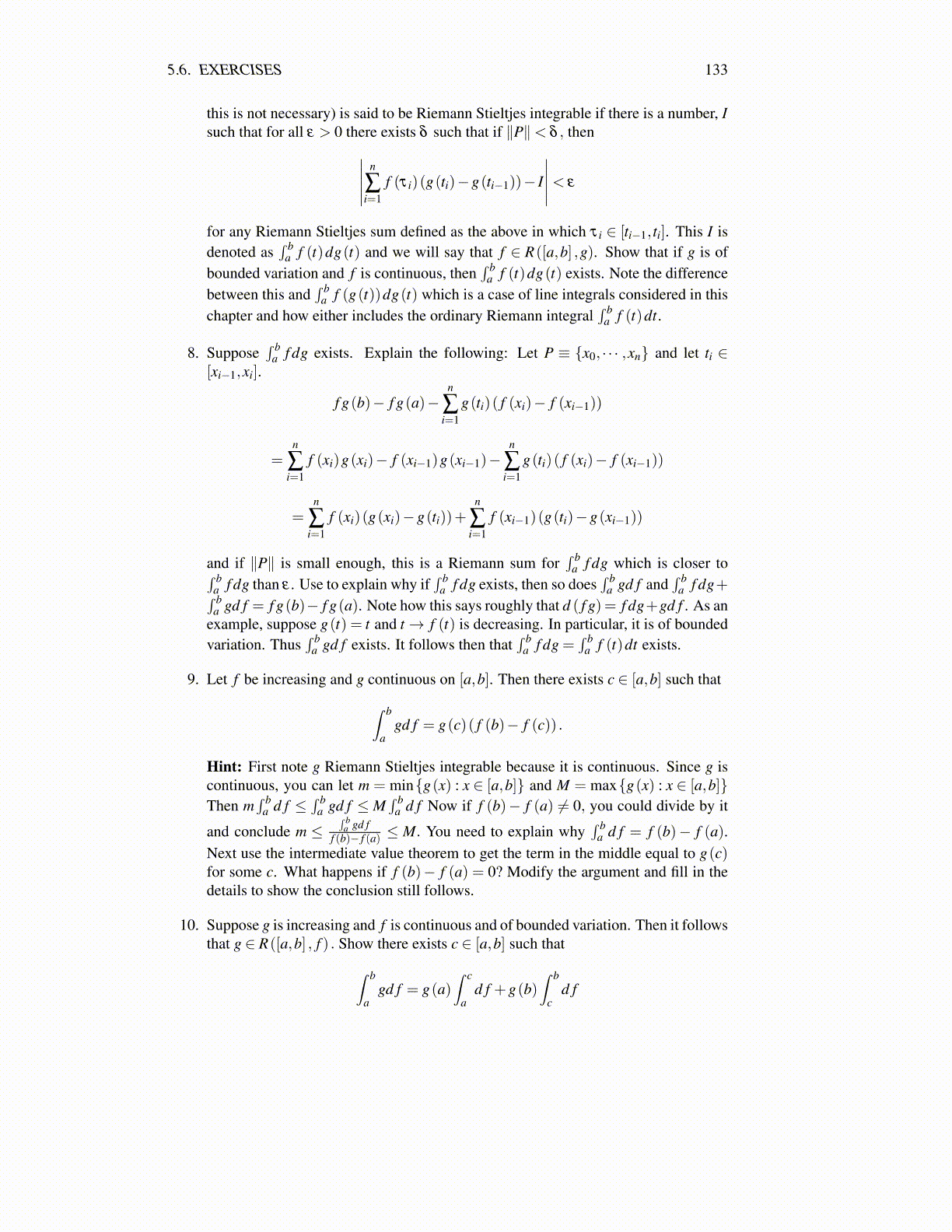
5.6. EXERCISES 133
this is not necessary) is said to be Riemann Stieltjes integrable if there is a number, Isuch that for all ε > 0 there exists δ such that if ∥P∥< δ , then∣∣∣∣∣ n
∑i=1
f (τ i)(g(ti)−g(ti−1))− I
∣∣∣∣∣< ε
for any Riemann Stieltjes sum defined as the above in which τ i ∈ [ti−1, ti]. This I isdenoted as
∫ ba f (t)dg(t) and we will say that f ∈ R([a,b] ,g). Show that if g is of
bounded variation and f is continuous, then∫ b
a f (t)dg(t) exists. Note the differencebetween this and
∫ ba f (g(t))dg(t) which is a case of line integrals considered in this
chapter and how either includes the ordinary Riemann integral∫ b
a f (t)dt.
8. Suppose∫ b
a f dg exists. Explain the following: Let P ≡ {x0, · · · ,xn} and let ti ∈[xi−1,xi].
f g(b)− f g(a)−n
∑i=1
g(ti)( f (xi)− f (xi−1))
=n
∑i=1
f (xi)g(xi)− f (xi−1)g(xi−1)−n
∑i=1
g(ti)( f (xi)− f (xi−1))
=n
∑i=1
f (xi)(g(xi)−g(ti))+n
∑i=1
f (xi−1)(g(ti)−g(xi−1))
and if ∥P∥ is small enough, this is a Riemann sum for∫ b
a f dg which is closer to∫ ba f dg than ε . Use to explain why if
∫ ba f dg exists, then so does
∫ ba gd f and
∫ ba f dg+∫ b
a gd f = f g(b)− f g(a). Note how this says roughly that d ( f g) = f dg+gd f . As anexample, suppose g(t) = t and t→ f (t) is decreasing. In particular, it is of boundedvariation. Thus
∫ ba gd f exists. It follows then that
∫ ba f dg =
∫ ba f (t)dt exists.
9. Let f be increasing and g continuous on [a,b]. Then there exists c ∈ [a,b] such that
∫ b
agd f = g(c)( f (b)− f (c)) .
Hint: First note g Riemann Stieltjes integrable because it is continuous. Since g iscontinuous, you can let m = min{g(x) : x ∈ [a,b]} and M = max{g(x) : x ∈ [a,b]}Then m
∫ ba d f ≤
∫ ba gd f ≤M
∫ ba d f Now if f (b)− f (a) ̸= 0, you could divide by it
and conclude m ≤∫ b
a gd ff (b)− f (a) ≤ M. You need to explain why
∫ ba d f = f (b)− f (a).
Next use the intermediate value theorem to get the term in the middle equal to g(c)for some c. What happens if f (b)− f (a) = 0? Modify the argument and fill in thedetails to show the conclusion still follows.
10. Suppose g is increasing and f is continuous and of bounded variation. Then it followsthat g ∈ R([a,b] , f ) . Show there exists c ∈ [a,b] such that
∫ b
agd f = g(a)
∫ c
ad f +g(b)
∫ b
cd f